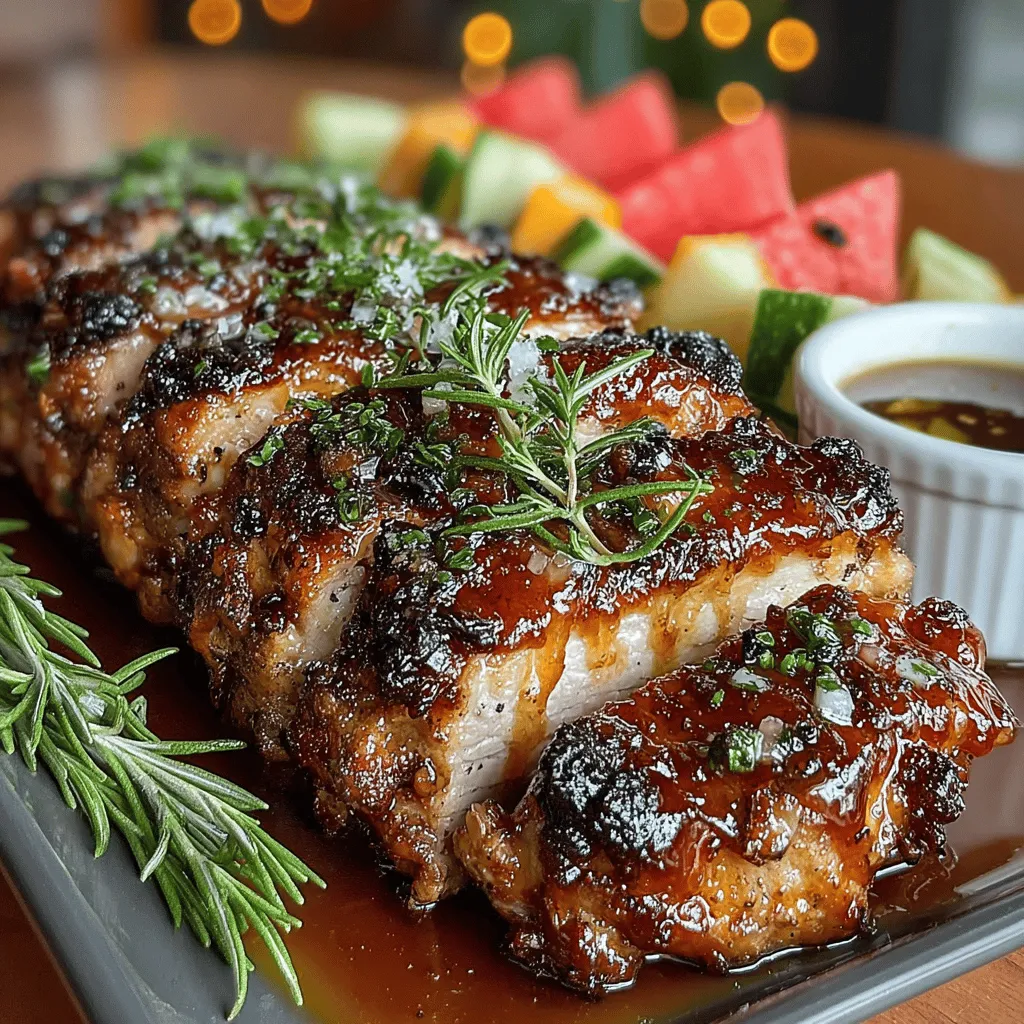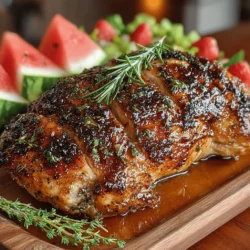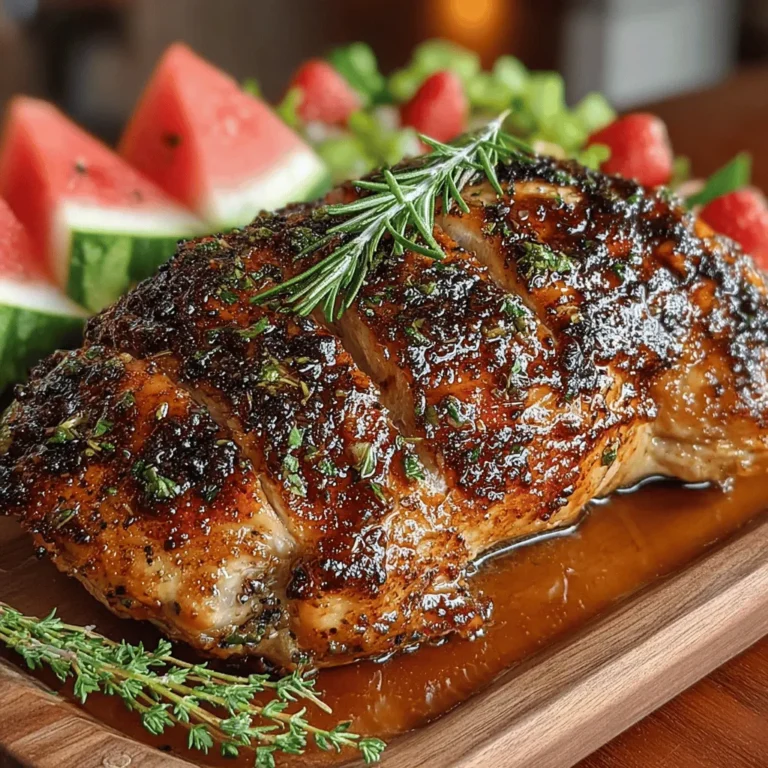Watermelon Glazed Turkey Recipe
As the holidays approach, many of us begin to plan festive meals that not only satisfy our taste buds but also impress our guests. Among the myriad of traditional dishes, the Watermelon Glazed Turkey stands out as a unique and vibrant centerpiece that captures the essence of seasonal flavors. This innovative recipe marries the sweet, refreshing taste of watermelon with the savory richness of turkey, creating a dish that is both visually stunning and deliciously memorable.
Incorporating seasonal ingredients into holiday meals is a time-honored tradition, and watermelon, typically associated with summer picnics, offers an unexpected twist to your holiday table. The bright pink hue of the glaze not only adds a pop of color to the turkey but also evokes a sense of celebration and freshness. This dish is perfect for those looking to break away from the monotony of typical holiday fare while still honoring the spirit of the season.
The combination of flavors in Watermelon Glazed Turkey is delightful and complex. The sweetness of the watermelon glaze complements the savory notes of the turkey, while the acidity from apple cider vinegar cuts through the richness, creating a balanced and harmonious dish. The result is a turkey that is not only juicy and tender but also bursting with flavor, making it a standout choice for any gathering.
Understanding the Ingredients
At the heart of the Watermelon Glazed Turkey recipe is the glaze itself, which relies heavily on fresh watermelon juice. Fresh watermelon juice is vital, as it provides the primary sweetness and flavor profile of the glaze. Opting for fresh juice instead of store-bought ensures that your glaze maintains the bright, vibrant flavor characteristic of ripe watermelon. This choice also enhances the overall quality of the dish, allowing the natural sweetness of the fruit to shine through.
Brown sugar plays a crucial role in the glaze, enhancing the sweetness and aiding in caramelization during the roasting process. The caramelized exterior not only adds depth of flavor but also contributes to the visually appealing golden-brown finish of the turkey. The balance of sweetness is key; too much can overwhelm the dish, whereas too little may not provide the necessary flavor contrast.
In addition to watermelon and brown sugar, the glaze includes apple cider vinegar, soy sauce, and Dijon mustard, which work together to create a nuanced flavor profile. The apple cider vinegar introduces a tangy note that cuts through the sweetness, while soy sauce provides umami richness, enhancing the overall taste of the turkey. Dijon mustard adds a subtle sharpness that rounds out the flavors, ensuring that each bite is a delightful experience.
Spices also play an important role in this recipe, with garlic powder, onion powder, and smoked paprika contributing layers of complexity. Garlic and onion powders introduce a savory depth that complements the sweetness of the glaze, while smoked paprika adds a hint of smokiness, elevating the dish to new heights. Together, these spices create a well-rounded flavor that enhances the overall enjoyment of the turkey.
To finish off the dish, fresh herbs serve not only as a garnish but also as a flavor enhancer. Herbs like parsley, cilantro, or mint can provide a refreshing contrast to the rich turkey and sweet glaze, making each bite even more enjoyable.
Preparing the Turkey
Before you can enjoy the deliciousness of Watermelon Glazed Turkey, it is essential to prepare the turkey properly. Thawing the turkey is the first step, and it is crucial to do this safely. If you have a frozen turkey, it’s best to allow it to thaw in the refrigerator. This method can take several days, so plan accordingly. For quicker thawing, you can submerge the turkey in cold water, changing the water every 30 minutes; however, this requires immediate cooking after thawing.
Once the turkey is thawed, the next step involves removing the neck and giblets, which are often found in a small bag inside the cavity of the bird. These can be set aside for making stock or gravy if desired. To remove them, simply reach inside the cavity and pull out the bag. Be sure to check both the main cavity and the neck cavity, as some turkeys may have both parts included.
After the turkey is cleaned and prepped, drying it thoroughly is essential for achieving crispy skin during roasting. Pat the turkey dry with paper towels, both inside and out, to remove excess moisture. This step is crucial, as moisture on the skin can lead to steaming rather than roasting, resulting in a less than desirable texture. A dry turkey will roast beautifully, allowing for that perfect golden-brown exterior that everyone loves.
With the turkey prepped and ready, you can move on to creating the delectable watermelon glaze that will elevate your dish to new heights.
Creating the Watermelon Glaze
To create the watermelon glaze, start by juicing fresh watermelon to yield about two cups of juice. This will serve as the base for your glaze and is where the magic begins. Once you have the watermelon juice, combine it with brown sugar, apple cider vinegar, soy sauce, Dijon mustard, garlic powder, onion powder, and smoked paprika in a medium saucepan.
Heat the mixture over medium heat, stirring frequently until the brown sugar dissolves. This initial step helps meld the flavors together, allowing them to infuse and develop a cohesive taste. Once the sugar has dissolved, bring the mixture to a gentle simmer. Simmering is a crucial technique in this recipe, as it allows the glaze to thicken and the flavors to concentrate. Keep in mind that the glaze should reduce by about one-third, resulting in a syrupy consistency that will cling beautifully to the turkey.
As the glaze simmers, take the time to taste and adjust the flavors to your liking. If you prefer a sweeter glaze, add a bit more brown sugar. If you like a tangier profile, a splash more vinegar will do the trick. The key is to find the perfect balance of sweet, tangy, and savory elements that will complement the turkey without overpowering it.
Once the glaze has thickened to your desired consistency, remove it from the heat and allow it to cool slightly. This will help prevent it from steaming the turkey when applied. When you’re ready to roast the turkey, brush the glaze generously over the bird, ensuring that it is well-coated. This layer of glaze will caramelize beautifully in the oven, creating a stunning finish that is sure to impress your guests.
With the glaze prepared and the turkey prepped, you are well on your way to creating a Watermelon Glazed Turkey that will be the highlight of your holiday feast. The combination of seasonal ingredients, thoughtful preparation, and careful attention to flavor will make this dish a memorable centerpiece at your table. As you embark on this culinary journey, you’ll discover the joy of bringing a fresh and unexpected twist to your holiday celebrations.

Marinating the Turkey
Marinating your turkey is an essential step in enhancing the overall flavor profile of this dish. The marination process allows the turkey to absorb the flavors of the glaze, resulting in a juicy and delicious meal. The watermelon glaze, infused with sweet and tangy notes, will penetrate the turkey, creating a mouthwatering experience for your palate.
Recommended Marination Times for Optimal Results
For best results, marinate the turkey for at least 4 to 6 hours, but overnight is preferable. This extended time allows for maximum flavor absorption. If you’re short on time, even a 2-hour marinade will still yield a flavorful turkey, but the depth of flavor will be less intense. Always ensure that the turkey is refrigerated during the marination process to prevent any food safety issues.
Tips for Ensuring an Even Coat of Glaze
To ensure your turkey is evenly coated in the watermelon glaze, follow these tips:
1. Use a Large Resealable Bag or Container: Place the turkey in a large resealable plastic bag or a container with a lid. Pour the glaze over the turkey, ensuring it is well-covered. Seal the bag or container, and turn it occasionally to ensure all areas of the turkey are coated.
2. Massage the Glaze: If using a bag, gently massage the glaze into the turkey, ensuring it gets into all crevices. This helps the flavors penetrate deeper into the meat.
3. Puncture the Skin: If you want to enhance flavor absorption further, use a fork to poke small holes in the skin of the turkey. This allows the marinade to seep into the meat more effectively.
Roasting the Turkey
Roasting the turkey is where the magic truly happens, transforming a simple poultry dish into a stunning centerpiece.
Importance of Preheating the Oven
Before placing your turkey in the oven, it’s crucial to preheat your oven to 325°F (165°C). Preheating ensures that the turkey begins cooking immediately, which helps in achieving an even roast and preventing the meat from drying out.
Step-by-Step Instructions for Roasting
1. Prepare the Turkey: Remove the turkey from the marinade and let it sit at room temperature for about 30 minutes. This helps it cook evenly. Discard the marinade.
2. Place in Roasting Pan: Position the turkey breast-side up on a rack in a roasting pan. A rack allows air to circulate around the turkey, promoting even cooking.
3. Tent with Foil: To protect the skin from burning while the turkey cooks, tent the turkey loosely with aluminum foil. This will allow the turkey to steam, retaining moisture during the roasting process.
4. Roast the Turkey: Place the turkey in the preheated oven. As a guideline, roast the turkey for about 13-15 minutes per pound. For example, a 14-pound turkey should roast for approximately 3 to 3.5 hours.
The Role of Basting
Basting is an essential technique in roasting that helps to maintain moisture and enhance flavor. Every 30-45 minutes, carefully remove the foil and baste the turkey with its pan juices. This process helps to keep the skin moist and promotes a beautiful golden-brown color. After basting, return the foil to keep the turkey protected. Basting is particularly important in the initial roasting period before the glaze has caramelized.
Achieving Perfect Caramelization
The key to a beautifully roasted watermelon glazed turkey lies in the caramelization of the glaze. This step transforms the turkey into a visually stunning and delicious dish.
Techniques for Achieving Crispy Skin and Caramelized Glaze
1. Remove Foil for the Last 30 Minutes: About 30 minutes before the turkey is fully cooked, remove the aluminum foil. This allows the skin to crisp up and the glaze to caramelize beautifully. Monitor the turkey closely during this period to ensure the skin does not burn.
2. Increase Oven Temperature: You can also increase the oven temperature to 375°F (190°C) for the last 30 minutes. This will help achieve a more pronounced caramelization of the glaze, creating a delightful contrast between the sweet crust and savory turkey.
Checking the Turkey’s Internal Temperature
To ensure your turkey is safely cooked, use a meat thermometer inserted into the thickest part of the thigh, avoiding the bone. The internal temperature should reach 165°F (74°C). If it hasn’t reached this temperature, continue roasting and check every 15 minutes. Once done, allow the turkey to rest for at least 20-30 minutes before carving to allow the juices to redistribute throughout the meat.
Resting and Serving the Turkey
Resting is a critical step that many overlook. After roasting, it’s essential to let the turkey rest before carving.
Importance of Resting the Turkey
Resting allows the juices to settle, ensuring a moist and flavorful turkey. If you carve it immediately, the juices will run out, leaving you with a dry turkey. Cover the turkey loosely with aluminum foil while it rests to keep it warm.
Techniques for Carving a Turkey
1. Use a Sharp Knife: A sharp knife will make slicing easier and ensure clean cuts.
2. Remove the Legs First: Start by removing the legs. Hold the turkey steady, and cut through the skin, then bend the leg back to dislocate it from the joint.
3. Carve the Breast Meat: Once the legs are removed, slice down along the breastbone, pulling the meat away from the bone as you go. This method provides beautiful slices for serving.
4. Serve on a Platter: Arrange the turkey slices on a large serving platter, showcasing the beautifully roasted meat.
Garnishing Suggestions
To elevate your presentation, consider garnishing your platter with fresh watermelon slices, herbs such as rosemary or parsley, and even some edible flowers. This not only enhances the visual appeal but also ties back to the watermelon theme of the dish, creating a cohesive and inviting presentation.
Conclusion
The watermelon glazed turkey is not just a meal; it’s a culinary experience that combines sweet, tangy, and savory flavors into a stunning dish. This recipe offers a unique twist on the traditional turkey, making it a perfect centerpiece for festive gatherings and special occasions. The vibrant glaze, paired with perfectly roasted turkey, is sure to impress your guests and leave them wanting more.
As you embark on making this watermelon glazed turkey, don’t hesitate to experiment with flavors and adjust the marinade to suit your taste. Whether for Thanksgiving, a holiday gathering, or a summer barbecue, this dish can become a beloved tradition in your household. Embrace the joy of cooking and share the delightful experience of this recipe with family and friends. Your watermelon glazed turkey will not only satisfy appetites but also bring smiles to faces, making every gathering memorable.


